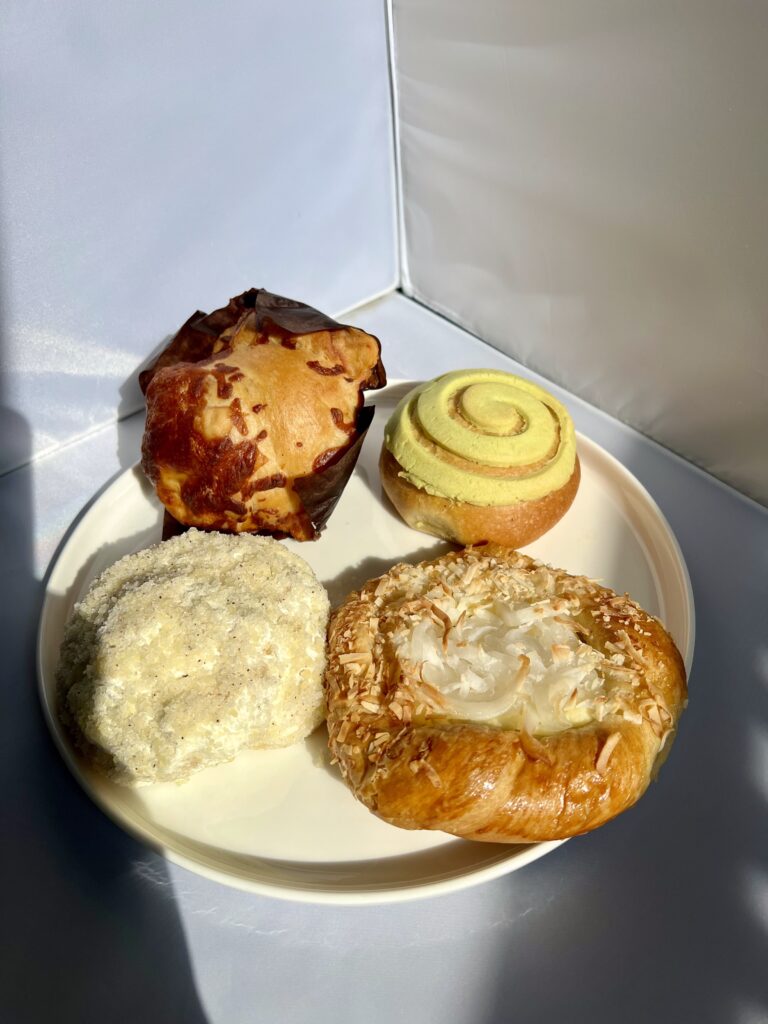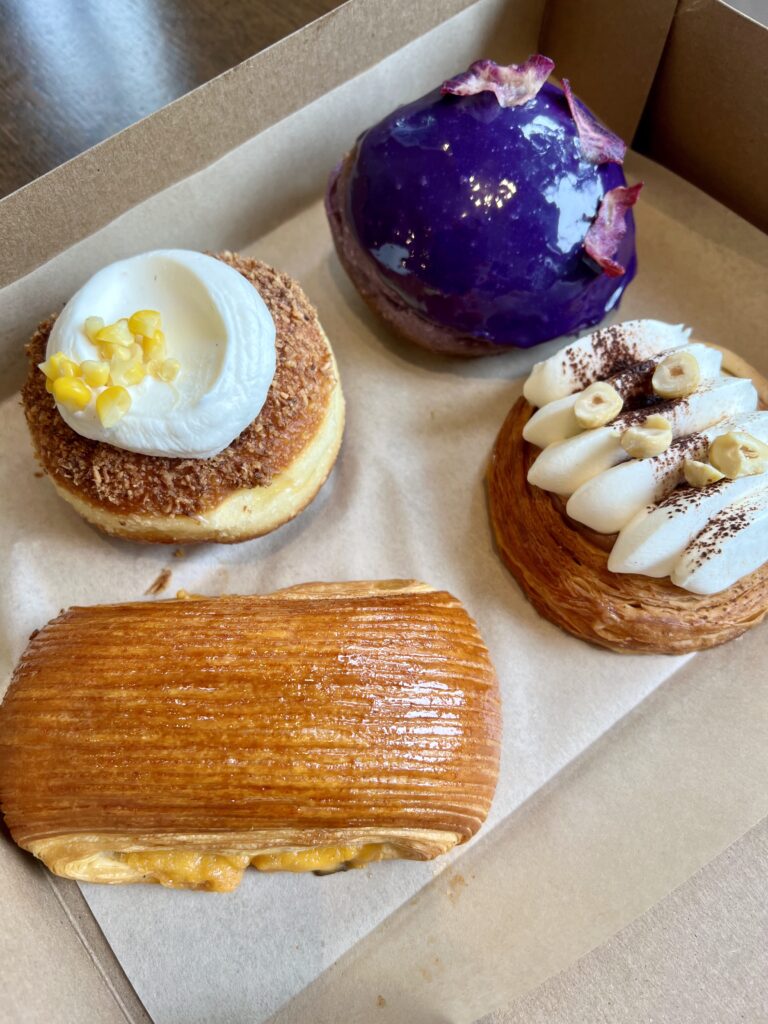From Pandesal to Pot Pies: A Guide to Filipino Bakeries In & Around NYC

In the Philippines, stopping by the neighborhood panaderya (or bakery) each morning is often as instinctive as pouring the first cup of coffee, the two usually go hand in hand. More than just places to buy daily bread, these bakeries embody a layered culinary history, where Spanish, Chinese, and American influences have long been folded into local traditions. Pandesal (soft, slightly sweet, bread rolls), ensaymada (fluffy, spiral-shaped bread topped with butter, sugar, and cheese), and other staples carry not only comfort but also the story of how Filipinos adapt flavors, ingredients, and techniques to feed their communities.
That same spirit of heritage and reinvention is alive and rising in New York City today, where Filipino-American bakers are reimagining the panaderya experience to preserve culture and build relationships with customers. Across the city and beyond, bakeries are serving both nostalgic classics and inventive spins — ube piayas, maja blanca donuts, and more — that showcase the adaptability of Filipino foodways. Baking here is about flavor, identity, and connection, honoring the past while experimenting with the present.
For Filipino American History Month, EnVi visited bakeries in and around NYC that are shaping this chapter of Filipino-American baking, carrying tradition forward while kneading innovation and creativity into every bite.
Arellano Pandesal

This Queens-based bakery is rethinking the beloved Filipino breakfast roll, offering twists that bridge tradition and modern cravings. What started from a humble family recipe for pandesal has been reimagined with care and creativity. Available primarily through their online shop and occasional pop-ups, Arellano’s menu speaks to “a new generation of Filipinos, Filipino-Americans, and people who just love great bread.”
What to Try:
- Classic Ensaymada – soft and buttery, topped with sugar, buttercream, and parmesan cheese.
- Mac ’N Cream Ensaymada – a spin on traditional ensaymada, this braided brioche bun is filled with macapuno cream cheese, brushed with calamansi, and topped with toasted coconut.
- Pan de Moon: Pandan Bun – a collab between Arellano Bakery and Moon Man, this pandesal bun is closer to a concha or pineapple bun, with a sweet and fragrant pandan kaya jam filling.
- Three Cheesy Unswirly (aka Ensaymada) – this unique, savory take on ensaymada features three aged cheeses (instead of typically-used Edam) layered with butter and rolled in shredded cheese for a perfect, robust bite.
Kape’t Torta
Translating to “coffee and cakes,” Kape’t Torta keeps things simple, soulful, and true to its roots. This spot is where you’ll find the classic panaderya staples that instantly transport you back home, whether that means the warm comfort of freshly baked bread at breakfast or the sweet nostalgia of childhood merienda (or snacks). The bakery leans into tradition, offering the everyday indulgences that make panaderyas such a vital part of Filipino food culture: breads meant to be enjoyed, savored, and shared, pastries best eaten with a hot cup of coffee. Every item here feels like a reminder of why panaderyas are more than bakeries, they’re clear cornerstones of community, memory, and daily ritual.
What to Try:
- Ube Cheese Pandesal – pillowy purple bread rolls with a gooey, salty-sweet center (best eaten warm).
- Pan de Coco – a true panaderya classic, sweet coconut-filled buns with a soft, buttery bite.
- Yema Cake – moist caramel sponge topped with a layer of caramelized custard frosting, sprinkled with shredded cheese for a balanced bite of sweet and salty.
Kora Bakery
Kora has become a standout in the Filipino-American baking sphere, skyrocketing from small-batch, weekend-only pickup orders to a storefront crowned “Queens’ Best Bakery.” Best known for their donuts inspired by Filipino flavors, Kora balances imagination and craft, serving pastries that are as layered with story as they are with flavor. Watching their skilled bakers fill each pastry with rhythmic precision turns the wait into part of the experience.

What to Try:
- Leche Flan ni Lola Donut – airy brioche donut filled with a rich, creamy, bouncy leche flan center, a signature pastry that put Kora on the map.
- Spam and cheese pan suisse – flaky, laminated dough filled with spam and pimiento cheese, brushed with hot honey; a perfect marriage of savory, sweet and subtle heat.
- Maja blanca donut – delicate corn and coconut cream-filled brioche topped with sweet corn and dark, roasted coconut.
- Food for the Goddesses Cookie – chewy, caramel-rich, filled with dates and walnuts with crisp edges — the perfect cookie based on the classic FFG bars that your lola (Tagalog for “grandmother”) might whip out around the holidays.
Panaderya Salvaje

Panaderya Salvaje (which translates to “wild” or “naughty”) lives up to its name, fearlessly pushing Filipino baking into bold new territories. Think sisig kolaches, dinakdakan pot pies, and trays of pastries that often sell out within a few hours of opening. Anticipation hums in the air as customers line up early, eyes frantically flicking toward the “pastry count” board that staff frequently update, heightening the suspense of the wait. Each creation is experimental, but the flavors are warmly familiar, and the buzz proves just how hungry people are for this kind of creativity and comfort.
What to Try:
- Ube Piaya – a flaky, unleavened Filipino flatbread pastry often filled with muscovado sugar, but the sweet, chewy ube filling is what makes it a standout here.
- Calamansi Olive Oil Loaf – dense, tender, and topped with toasted meringue and a tangy, sweet calamansi curd.
- Tablea Brownie – rich, fudgy, and moist with a deep chocolate flavor from Filipino cacao, and a perfectly crackled top.
Purple Dough
A neighborhood gem tucked near Queens’ “Little Manila,” Purple Dough elevates ube, the prized purple yam, into donuts, cannolis, cakes, and other treats with Filipino flair. Each item balances Filipino flavors with playful, modern twists, offering a feast for both the eyes and the palate. Whether you’re stopping by for something nostalgic or just looking for something entirely new, Purple Dough’s vibrant pastries deliver on both taste and presentation.
What to Try:
- Ube cannoli – a crunchy, golden shell piped with a creamy ube filling, subtly floral and sweet. a Filipino-Italian mash-up.
- Ube leche flan – a decadent, double-layered treat combining dense, violet-hued ube cake and velvety smooth leche flan, where earthy yam meets silky sweet custard.
- Ube silvanas – delicate, buttery meringue wafers sandwich a creamy, pastel-purple ube buttercream, all lightly rolled in crushed cashews for a nutty, earthy crunch.
Red Ribbon Bakeshop
“Proudly Filipino-owned since 1979,” Red Ribbon has grown from a single, family-owned shop into a household name with more than 500 locations worldwide. For many Filipino families, their bright red boxes symbolize special occasions and celebrations. From airy mamon to decadent mango or ube cakes layered with cream, Red Ribbon’s offerings carry with them a sense of joy and tradition that continues to connect generations.
What to Try:
- Butter Mamon – their cult-classic chiffon cake, melt-in-your-mouth soft and buttery (also comes in ube, mocha, and cheesy flavors).
- Chicken Empanadas – flaky pastry pockets with a savory chicken filling.
- Mango Supreme Cake – tropical and creamy, layered with sweet mango slices and mango-flavored cream; a must for fruit-forward dessert lovers.
From classic staples to inventive twists, Filipino bakeries in New York and beyond are baking more than just bread and pastries, they’re crafting connections to heritage, community, and identity. Each bite, whether nostalgic or novel, tells a story of tradition carried forward and reinvented.
Today’s new wave of Filipino-American bakers aren’t only preserving traditional foodways, they’re also sparking curiosity and joy by pushing the possibilities of Filipino flavors forward. Through reconnection, rediscovery, and reiteration, each colorful bread or playful pastry offers a cross-cultural perspective, weaving together history and identity into a vibrant new culinary legacy.
In search of more Filipino food recs? Check out EnVi’s guide to New York City’s Little Manila here!



